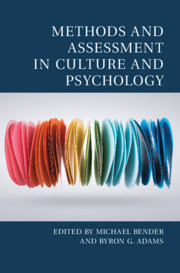Book contents
- Methods and Assessment in Culture and Psychology
- Culture and Psychology
- Methods and Assessment in Culture and Psychology
- Copyright page
- Dedication
- Additional material
- Contents
- Figures
- Tables
- Contributors
- Foreword
- 1 Introduction to Methods and Assessment in Culture and Psychology
- Part 1 Acculturation and Identity
- Part 2 Individual Differences across Cultures
- 6 Broadening the Bases of Methodological Rigor in Cross-Cultural Educational Assessment
- 7 Individuals, Groups, and Classrooms: Conceptual and Methodological Considerations on Studying Approaches to Cultural Diversity in Schools
- 8 Emotion between Universalism and Relativism: Finding a Standard for Comparison in Cross-Cultural Emotion Research
- 9 Culture Is More Than Self-Reported Motives, Beliefs, and Values: Methodological Advancements of Measuring Implicit Motives across Cultural Contexts
- 10 Development of the South African Personality Inventory: A Cross-Cultural Design in a Non-Western Society ‒ Lessons Learned and Generalizability to Other Parts of the World
- 11 Combining Global and Local Approaches in Psycholexical Studies: Glocal Illustrations from Studies on Arabic
- Part 3 Culture and Assessment
- Index
- References
8 - Emotion between Universalism and Relativism: Finding a Standard for Comparison in Cross-Cultural Emotion Research
from Part 2 - Individual Differences across Cultures
Published online by Cambridge University Press: 21 January 2021
- Methods and Assessment in Culture and Psychology
- Culture and Psychology
- Methods and Assessment in Culture and Psychology
- Copyright page
- Dedication
- Additional material
- Contents
- Figures
- Tables
- Contributors
- Foreword
- 1 Introduction to Methods and Assessment in Culture and Psychology
- Part 1 Acculturation and Identity
- Part 2 Individual Differences across Cultures
- 6 Broadening the Bases of Methodological Rigor in Cross-Cultural Educational Assessment
- 7 Individuals, Groups, and Classrooms: Conceptual and Methodological Considerations on Studying Approaches to Cultural Diversity in Schools
- 8 Emotion between Universalism and Relativism: Finding a Standard for Comparison in Cross-Cultural Emotion Research
- 9 Culture Is More Than Self-Reported Motives, Beliefs, and Values: Methodological Advancements of Measuring Implicit Motives across Cultural Contexts
- 10 Development of the South African Personality Inventory: A Cross-Cultural Design in a Non-Western Society ‒ Lessons Learned and Generalizability to Other Parts of the World
- 11 Combining Global and Local Approaches in Psycholexical Studies: Glocal Illustrations from Studies on Arabic
- Part 3 Culture and Assessment
- Index
- References
Summary
This chapter combines developments in the emotion literature with developments in cross-cultural methodology in order to formulate four recommendations that can bridge the gap between relativist and universalist views on cultural variation in emotion. We recommend that researchers (1) specify the emotions or facets of emotions they study, preferably using a multi-componential approach to assessing emotions; (2) check the equivalence across languages and cultures of the emotion vocabulary they use, either by existing data bases or by including the measurement of meaning in their design; (3) specify the level at which they compare emotions across cultures ranging from descriptions of culture-specific constructs to direct comparisons of mean scores, and apply adequate methods to demonstrate the level of comparability claimed; and (4) account for both similarities and differences when they formulate hypotheses, as well as when they interpret their data. These recommendations are illustrated with historical and contemporary cross-cultural emotion research.
- Type
- Chapter
- Information
- Methods and Assessment in Culture and Psychology , pp. 144 - 169Publisher: Cambridge University PressPrint publication year: 2021
References
- 4
- Cited by

